
Portable Power for Your 4Runner and Dometic Fridge Using the Goal Zero Yeti 500X Power Station
Goal Zero has been at the forefront of portable power for over a decade beginning with lead-acid power sources that were more comparable to a car battery. As technology has evolved, lead-acid batteries have been slowly replaced with lithium-ion because they are generally more stable and can pack more power into a lighter package.
Goal Zero introduced their lithium-based power stations in 2017 in a variety of models ranging from 400Wh to 1400Wh, eventually adding versions as large as 3000Wh to the line-up.
In late 2019, we were introduced to the newest line from the power gurus, the X-series. Promising more power out of a smaller package, the Yeti 200X and 500X were born!
I’m going to show you some of the new features of the Yeti 500X, how it pairs with the Nomad 50 portable solar panel and how the whole package works in and around the 4Runner platform.
Find these products:
- Goal Zero Yeti 500X: Check Price
- Goal Zero Nomad Solar Panel (50W): Check Price
- Dometic CFX3 55: Check Price
In this article, we used the 500X and one Goal Zero Nomad Solar Panel (50W) solar panel. That was used to power our Dometic CFX 55 which Dometic has since been upgraded to the CFX3 55. Below, you will find the full fridge test and our findings.
More Power, Smaller Package

The 500X hits a sweet spot for portable power in our SUVs, it’s easy to stash and still packs enough power for a weekend’s escape. It was built to replace the existing Yeti 400 Lithium and includes some great upgrades. As a package, the 500X has the same footprint as its predecessor, but it’s just over an inch shorter.
The same reduction can be found with it’s weight, 12.9 pounds compared to the 400’s 16.3 pounds. So it’s about 20% smaller, which is a great convenience in a packed vehicle.
What about the power capacity, did that also decrease? In-fact, no. Despite being lighter and smaller, the 500X has an increased power capacity of just over 500-watt hours from the 400’s 428-watt hours.
In terms that are more familiar with those that are used to upgrading vehicle batteries, this power station packs just over 42Ah of power at 12v. That’s more than enough juice for powering a fridge and accessories in camp.
What Can You Power with the Yeti 500X?

The Yeti 500X carries over many of the same port options as the older 400, but includes some welcome additions. You might have noticed already, but USB-C accessories are gaining popularity with modern electronics. Laptops, tablets, and even some phones are switching over to this port style.
Previously, Goal Zero Power Stations didn’t include an option for USB-C ports. You needed to plug an adapter into the AC outlet to charge your device. To solve this dilemma, two USB-C ports have been added to the 500X’s array.
An 18W outlet suited for lower demand devices like an iPad, and a powerful 60W port for your laptop!
Welcome to the future or powering your accessories on the trail.
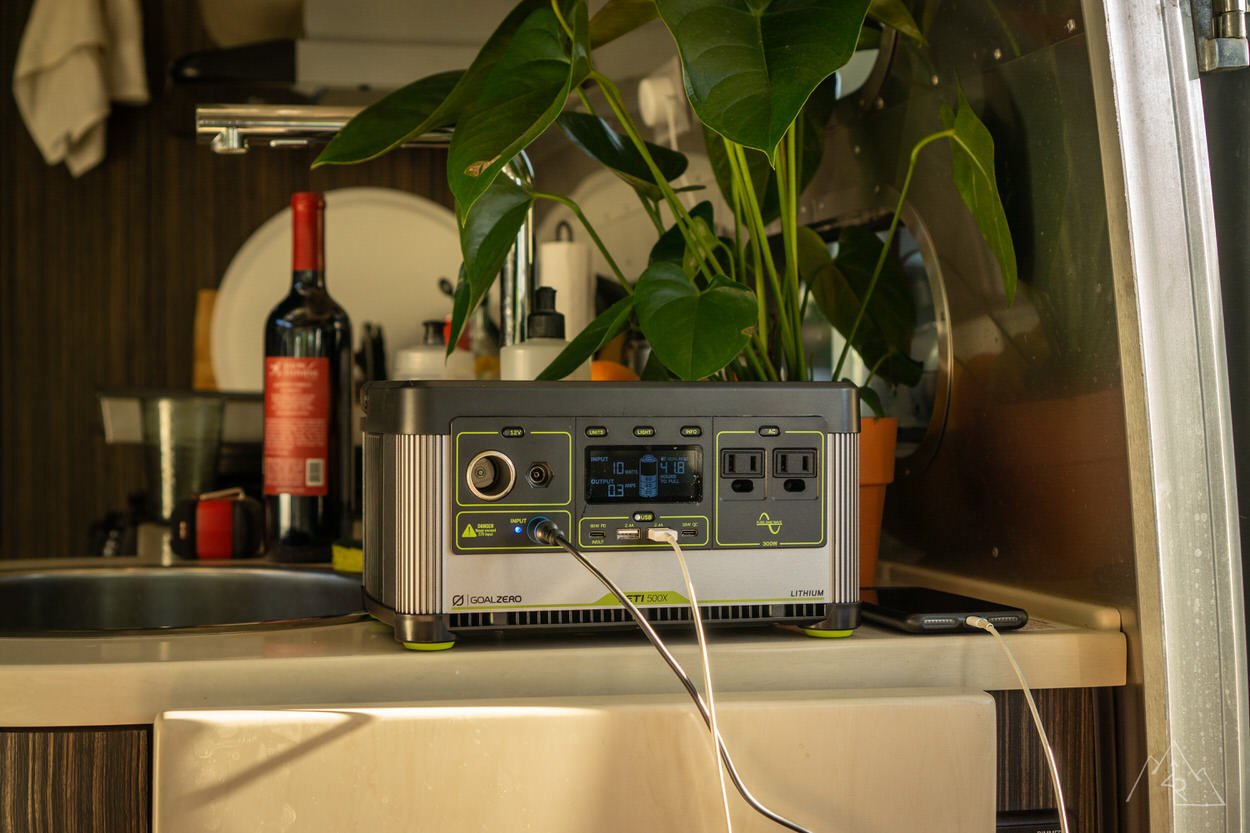
Along with those welcomed USB-C ports there are options for two USB-A ports, two 300W (combined) AC outlets, a 12v car port, and a 12v 6mm plug. With these options provided, you’d be hard-pressed to not find a charging solution for your needs. From an iPhone to a Milwaukee chainsaw, the 500X has your charging needs covered.
The Fridge Test
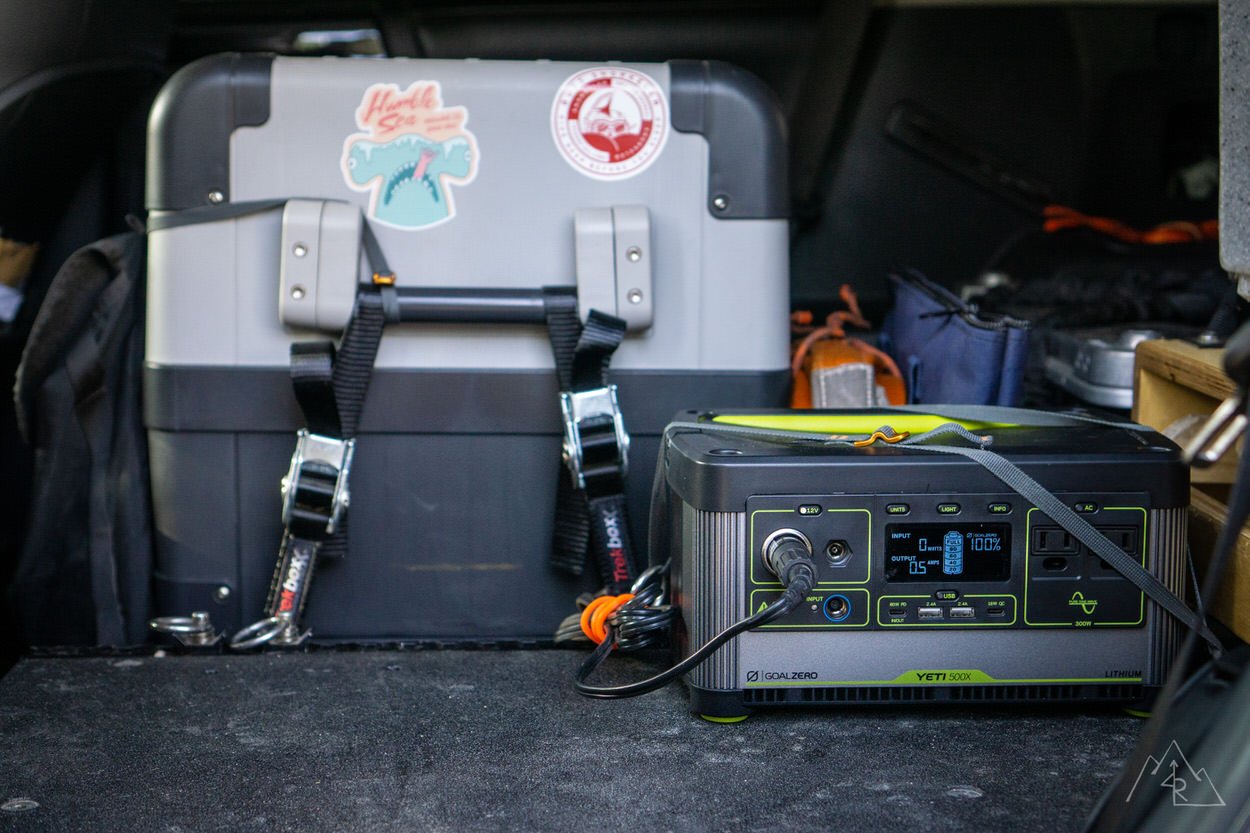
Now for the age-old question, “Will the Yeti 500X power my fridge?” Yes!
The reason I joke about this inquiry is that portable fridges are one of the most power demanding items in the back of most 4Runners heading out into the woods for the weekend, making them the main catalyst for someone wanting to upgrade their power system.
I tested the Yeti with my Dometic CFX 55 in a controlled environment plugged into the 500X’s 12v port to get a sense of how long I could expect it to last over a weekend.
I tried to be as detailed as possible to make my approximations accurate for the Yeti’s lifespan when staying at the same spot on a camping trip for multiple days.
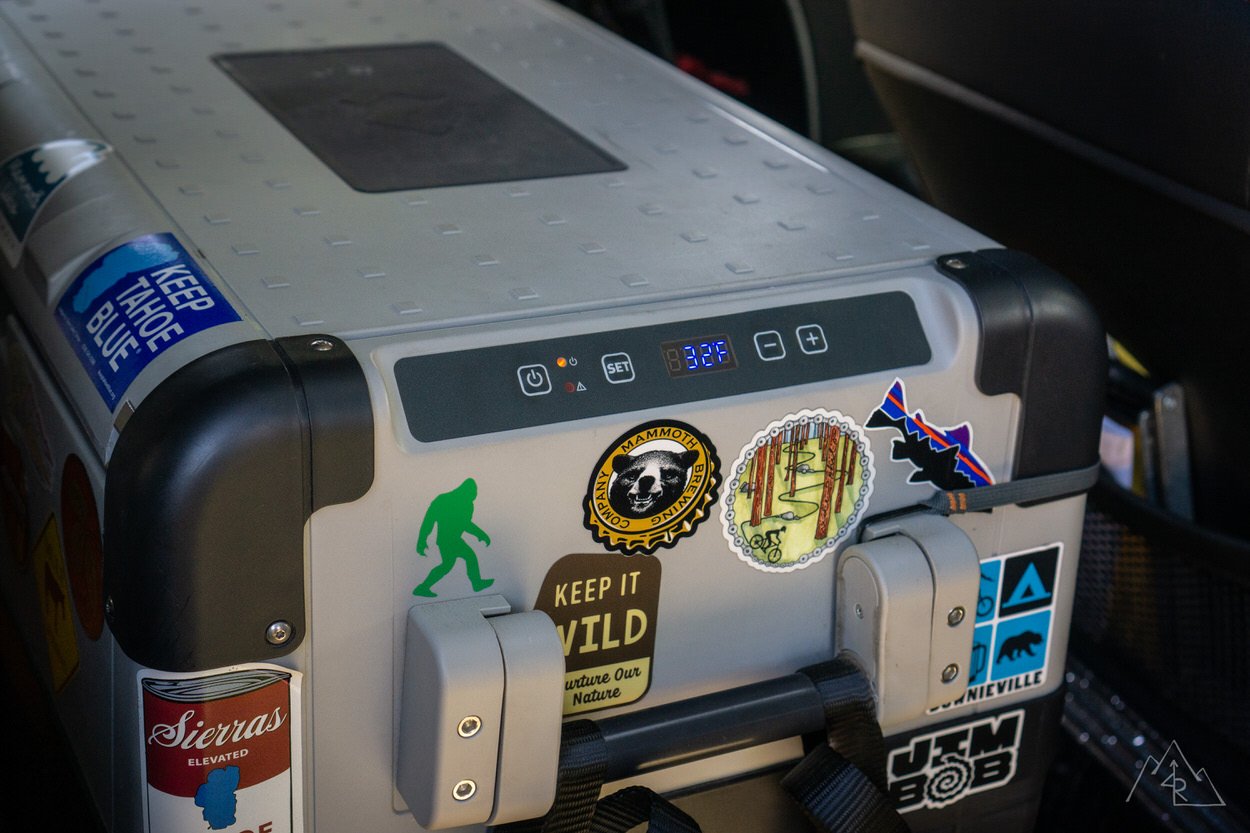
To start, I loaded the fridge with 3 gallons of water, some beers (for after the test), and filled the remaining space with a couple of beach towels to simulate a “full fridge”.
I also pre-cooled the fridge overnight using house power like I do before every trip to get everything inside nice and cold, and the fridge to its optimal efficiency.
To simulate “being in camp”, I measured the outdoor temperature, the temperature inside the 4Runner, the temperature inside the fridge, and the Yeti’s power level every hour over a 24 hour period.

Starting at 100% charge, the Dometic was plugged into the 500X at 8 in the morning to begin the test. The fridge was set to 32ºF and was reading a stable interior temperature of 41ºF (using a 3rd party thermometer). As measured, when the compressor on the Dometic was running it would draw about 4 amps, and 0.5 amps or less when idling. The fridge was opened at breakfast, lunch and dinner times (9am, 1pm, 6pm) for 30 seconds to “get food out” and 30 seconds to “put food away”. It was also opened for a “snack or beverage” at 11am, 4pm and 9pm for a 15 second duration. I had the front windows rolled down and the rear hatch open to simulate interior temperatures when camping.
Check out the graph below for all of the data!

At the end of the 24 hour period, the fridge had consumed 43% of the 500X’s power without any solar input or charging from the vehicle’s battery! That’s seriously impressive for a device that weighs less than a couple of 6-packs of beer.
At that rate, you could expect to camp for up to 55 hours without any additional charging while keeping your fridge set to 32 degrees. For a weekend trip, that’s more than enough power for the fridge and some additional devices while posted up at your favorite summer campsite.
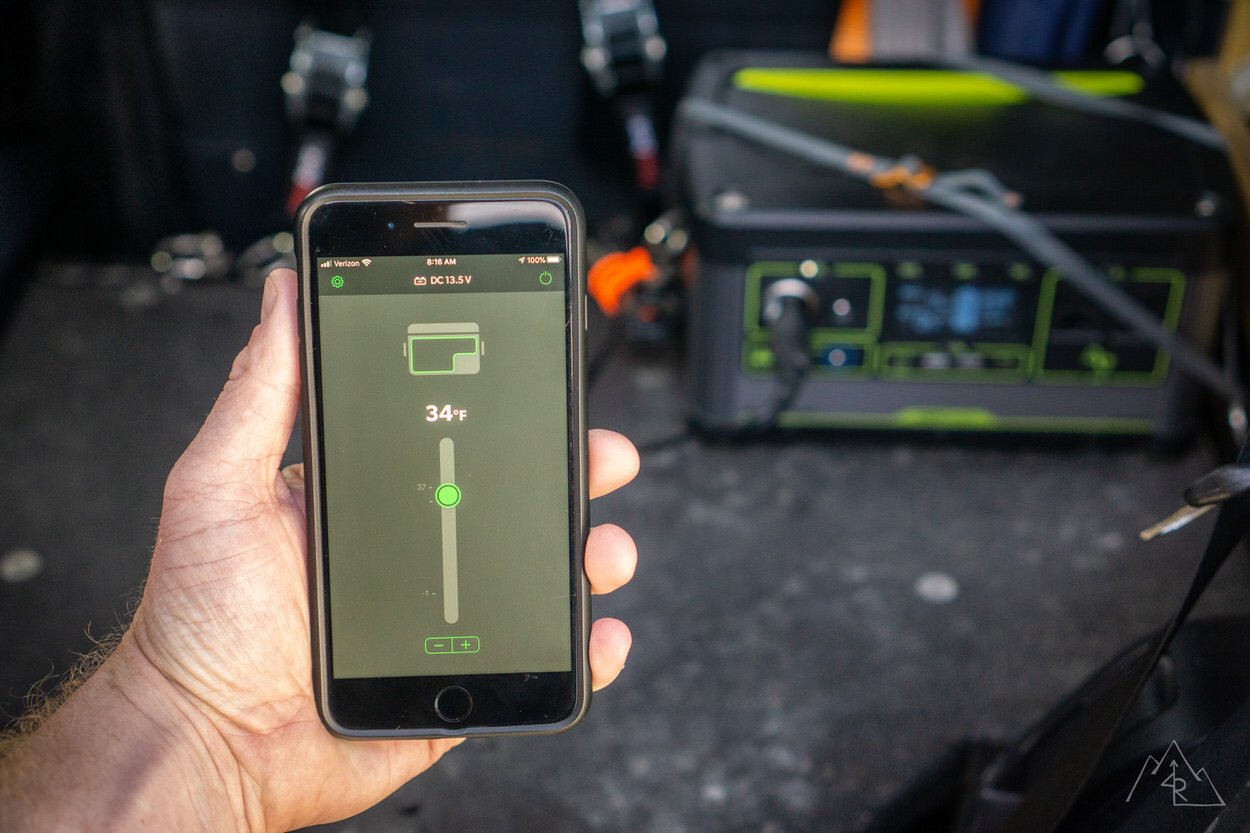
One more detail worth noting is that the fridge was receiving 13.5v of power as shown on the Dometic App. Some users of previous versions of the Yeti reported an incoming voltage that was consistently lower than 12v when having a fridge plugged into the 12v outlet, ultimately causing the fridge to turn off. The X-series Yeti seems to have solved that issue with more than enough voltage to keep the Dometic happy and above its low-power cutoff.
What Can Power the Yeti 500x?
So you have a Power Station, and are planning to use it. At some point, you’ll need to replenish what you’ve used, and with Goal Zero’s help there are a few options for that. Charge times will vary based on the input power and are listed below:
- Wall charger: 8.5 hours
- Car charger: 4.5 hours
- Solar Panel: 12-24 hours (50W panel)
The wall charger allows you to fill your Yeti to capacity before heading out on a trip, and will keep it constantly trickle charged while you’re at home. It’s not designed to rapidly charge the Yeti based on its wattage output and should be used when time is not an issue.
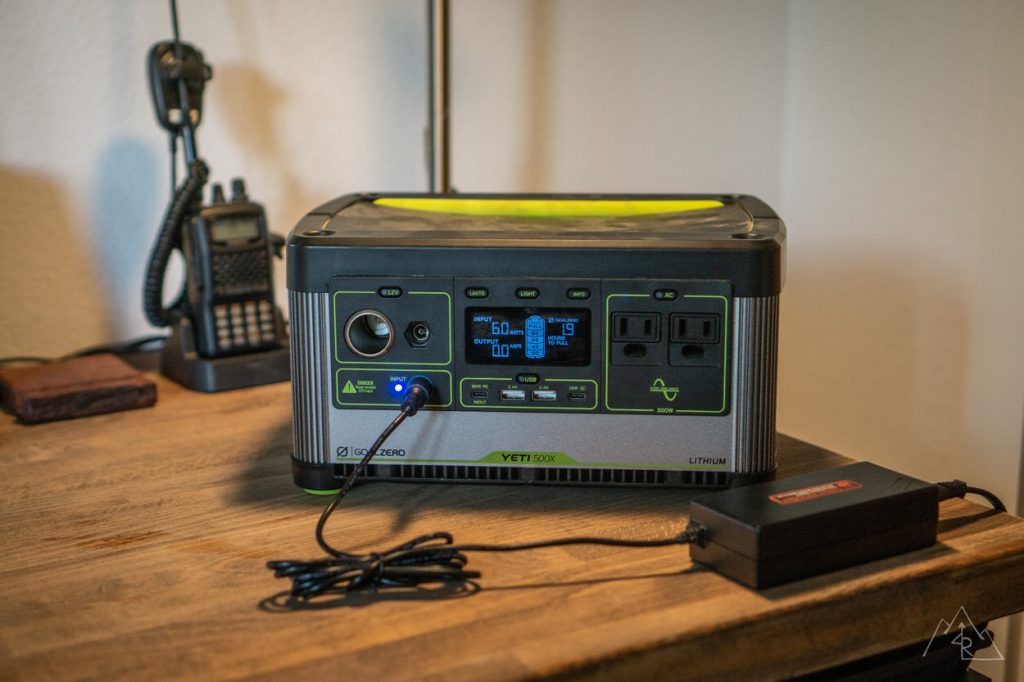 The car charger is a great way to keep your 500X topped off while on the road. Planning to move between campsites for the day? Plug it into your vehicle’s 12v car charger and allow it to regain what it’s lost overnight. This will extend your camping trip and keep the overnight demand off of your vehicle’s battery.
The car charger is a great way to keep your 500X topped off while on the road. Planning to move between campsites for the day? Plug it into your vehicle’s 12v car charger and allow it to regain what it’s lost overnight. This will extend your camping trip and keep the overnight demand off of your vehicle’s battery.
Nomad 50 Solar Panel
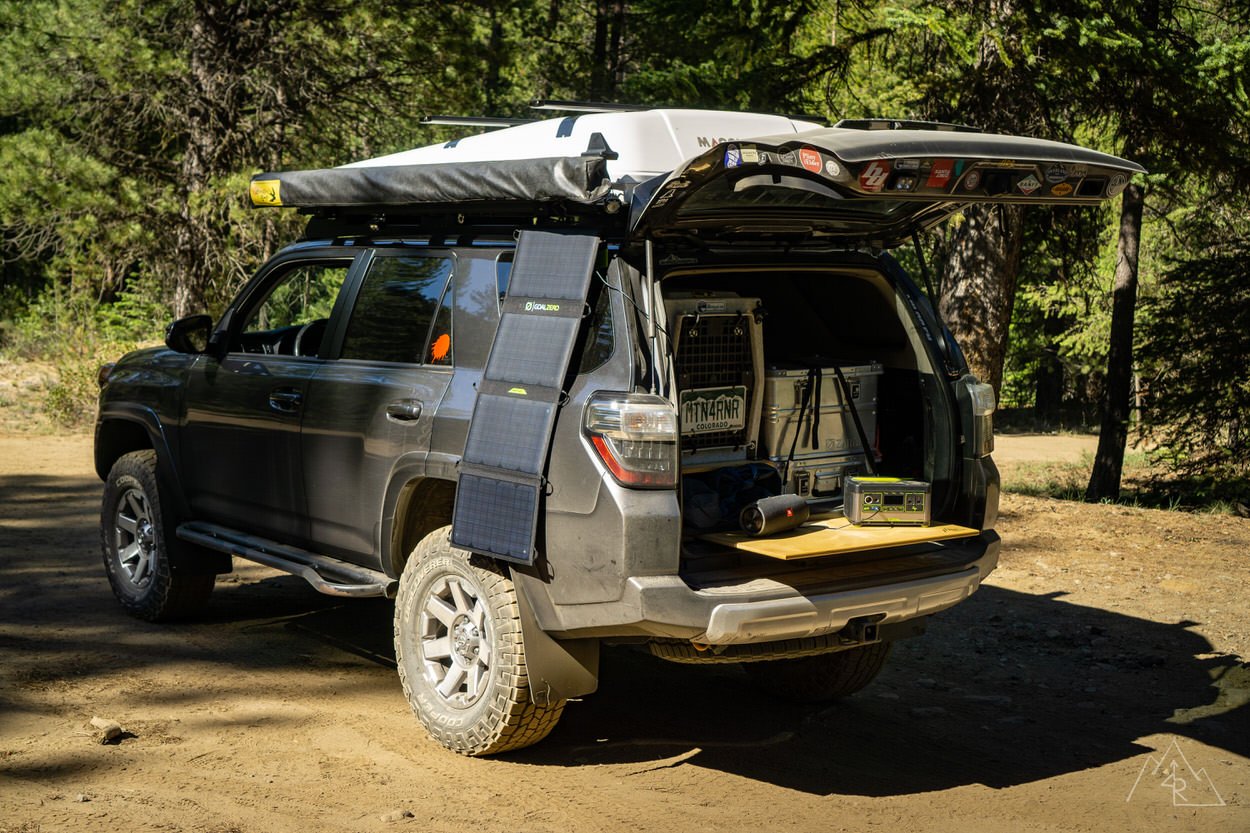
Another great way to keep your battery charged and ready is by using a solar panel. They can be attached to the roof or hood of your vehicle if you want a permanent mount, or you can opt for a portable version to keep your options flexible.
I tested out the Nomad 50 from Goal Zero to keep the 500X charged.
This portable solar panel is great because it can be moved around the campsite to keep it in optimal sunlight throughout the day and won’t require you to park your 4Runner in the sun to stay charged.
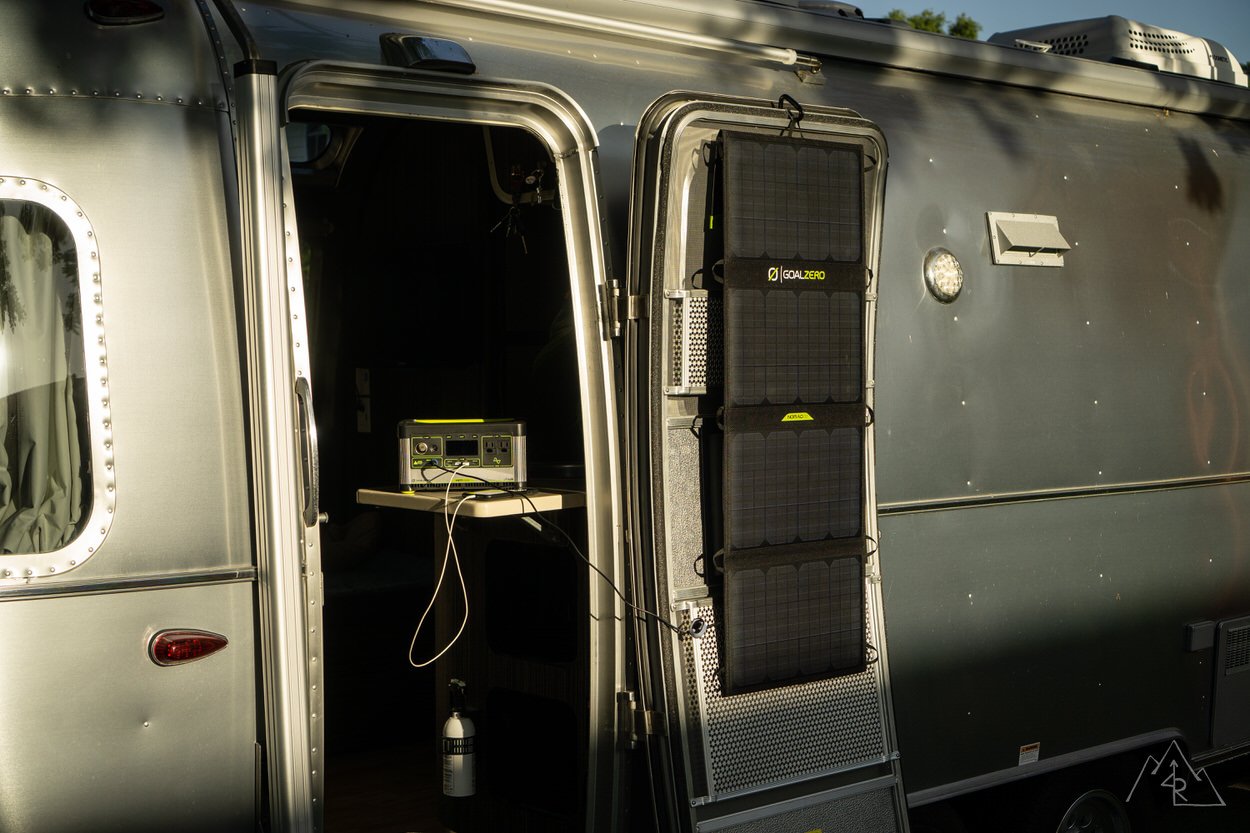
This panel can put out up to 50W of power in perfect sunlight conditions, which will charge your 500X in 12 hours.
One thing I have noticed is that I haven’t been able to achieve the maximum output since using it. Even when changing the orientation and angle, I have only been able to coax around 35W out of it at any given time. Now there are a lot of variables for solar panel outputs and efficiencies, but this is my observation and should be taken with a grain of salt.
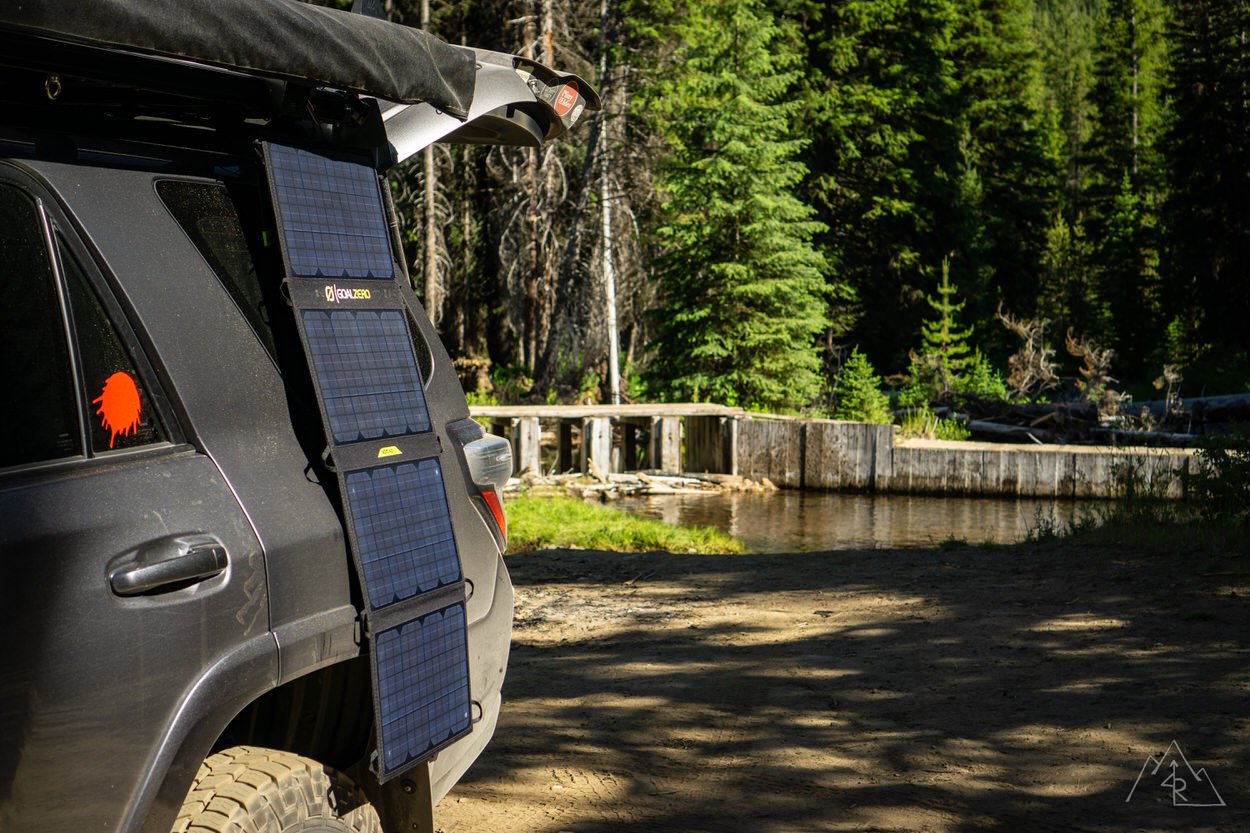
For my use, this solar panel has been great. It offsets a portion of the fridge’s power consumption during the day, and packs up to an easy to pack size in the 4Runner while on the road. I would recommend adding an extension cable to your order to allow you some flexibility with how far away you can place the panel to keep it in the sun all day!
The Trail Takeaway
Since receiving the 500X, I have brought it along on each one of my camping trips to power my Dometic and other devices in camp. It’s small enough to easily store amongst my camping gear, powerful enough to keep my beers cold for a weekend and allows for more flexibility than a dedicated dual battery system.
It also has the added benefit of being portable, meaning I can throw it in multiple vehicles or bring it inside the house when the power goes out. That’s something that you can’t do with a vehicle-based dual battery system.
Am I saying that the Yeti 500X is a replacement for a well designed dual battery system? Not entirely… Not for everyone. I would bet that the majority of you reading this article who have been thinking about adding more power capacity to their rig would have all of your needs met by the Goal Zero Yeti 500X, in a much simpler package.
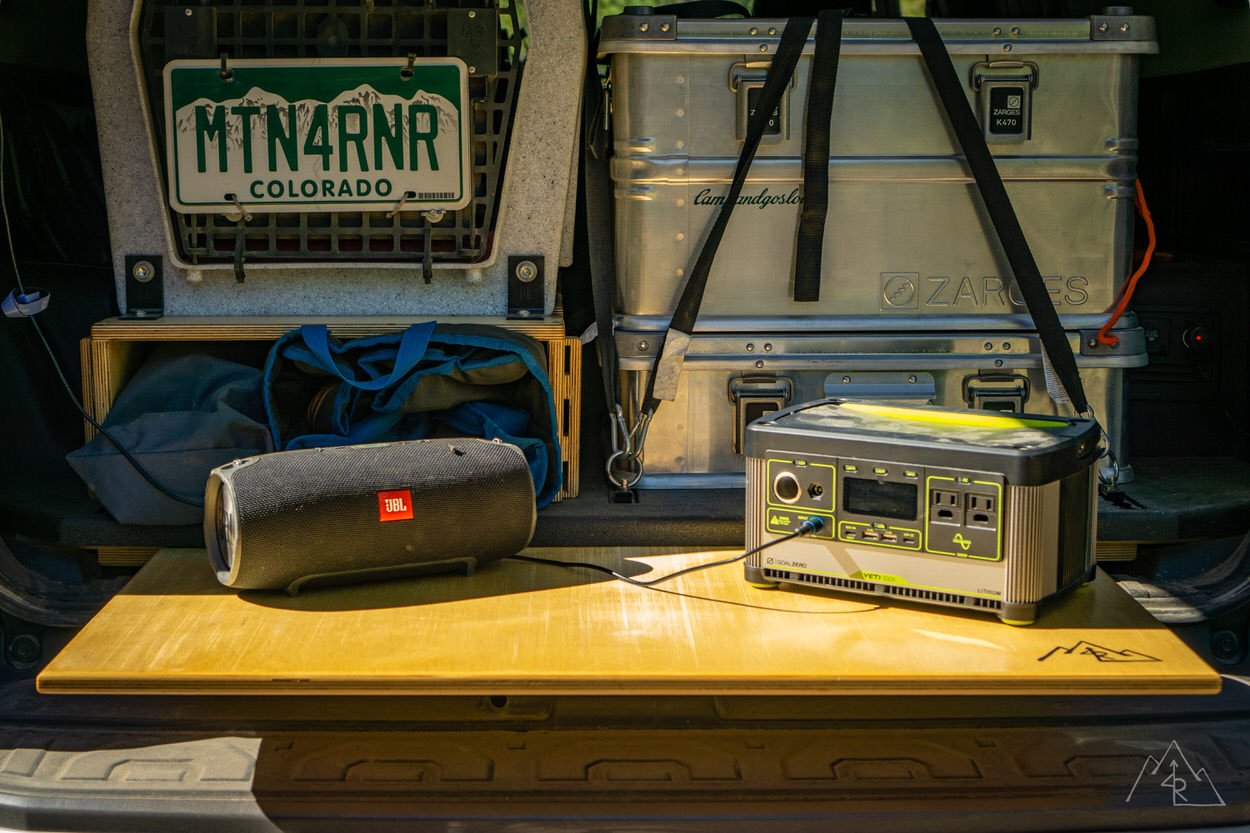
What’s powering your adventures? Let us know in the comments below!

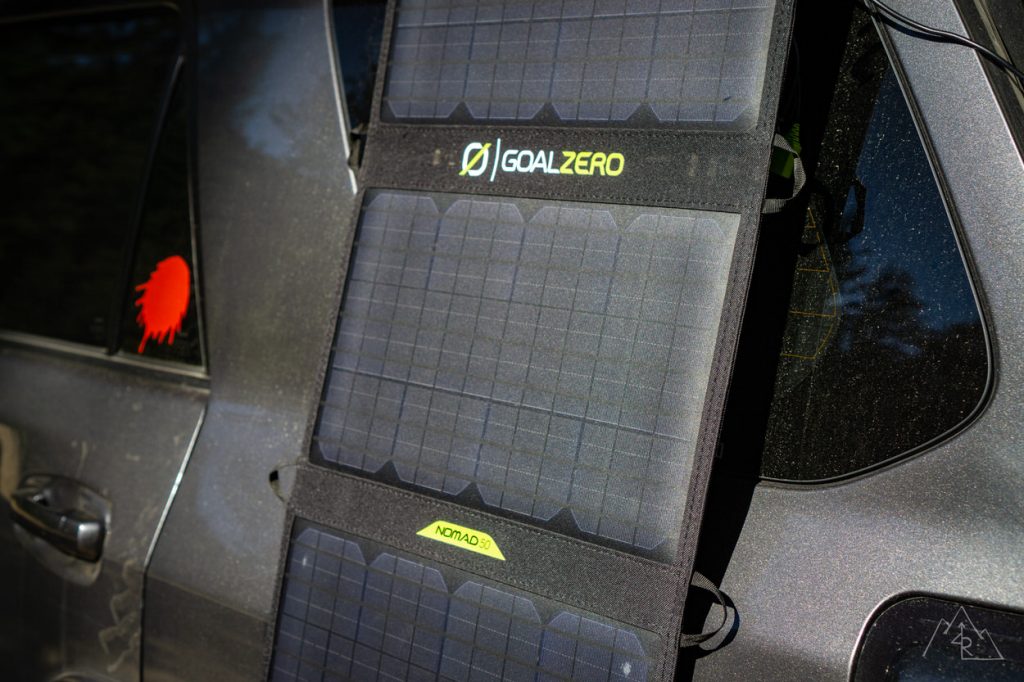

My Yeti500X disconnects outlets every 30 hours, which for my use is a NO GO!
I first thought of a bug while reading furoms and sent the unit back for repair.
It was sent to me with a notice “it’s standard to save battery life”.
Is there any way to get this fixed to avoid this? I have this unit placed on a roof where I will only get access 3-4 times a year for “emergency” cases.
I know this is a little late to the party but I’ve been trying to get my 500x to work with my CFX3 35. It will usually trip the regulated 12v breaker on the 500x which requires a reset. I’ve had it trip within an hour of starting the fridge or 8hours of runtime later. It seems to be very random. Ive borrowed an old yeti 1000 lithium and have had zero issues and ran the Dometic with no 12v issues for 11days straight. I’m starting to think the regulated circuit in the goal zero just doesn’t like my dometic.
I have also received a “warning 33” from running the dometic on the yeti 500x
What is the life span of yeti 500? Mine reads 4224 watts used. How can I tell cycles?
Do you know if the battery in the 500x is replaceable? If so what is the cost? Can you swap it yourself or do you have to send the unit back to GZ?
I’ve been using the 500X with a Renogy 100W briefcase. At its peak, we have reached a 95W input to the GZ. Both are great and powers our CFX3 55IM amazingly well, as you reported!
I just purchased one of these and will be attempting the same setup with an ICECO JP40 Fridge. Keep yal posted…
great article ! I gotta tell ya I’m a fan of Yeti products, and as Max stated its portable making it a great source of power for more than just your awesome fridge.
Keep em comming.
Hi Max, thanks for the detailed writeup. I am currently looking at Yeti 500X and the cheaper Jackery Explorer 500.
Based on their specs, do you think that they will perform similarly?
Thank you!
Carlo // I think that from a capacity stand-point they are comparable (Jackery 518Wh to GZ 505Wh). Looking at the features, it seems to fall short. Lack of USB-C chargers, only one 110v port. BUT that all depends on what you need from your power station. I would also note that the 12v Car Port on the Jackery isn’t noted as being regulated, which could affect it’s ability to power certain items. // Max
Max, Thanks for this write-up! I have (almost) the exact same setup, and have sadly found the 500x to be insufficient.
For context, I have a Yeti 500X paired with the Dometic CFX3 35. I’ve found with the Dometic plugged into either the 12V DC plug and/or 120V AC plug on the Yeti, I get a warning message on the Dometic stating “Warning 33” “Compressor Start Fail”. Seems like the Yeti 500X can’t handle the amps required to kick on the compressor. I spoke with the Service Team at Dometic, and they confirmed it sounds like a power source problem, and not a Dometic problem.
Have you encountered a similar problem with the Compressor failing to start?
Hi Nick,
Were you able to resolve your issue? I have the same issue.
Nick,
I have the CFX3-35 running off of a Jackery 500 and have not had the problem you describe. Maybe an issue with the Dometic.
Nick // Interesting observation, I haven’t had that issue here with my CFX50 regarding a current related failure to perform. I have run my fridge from both sources and have read a maximum amp draw of about 4A or so from the Dometic when the compressor is running. I can’t imagine that the CFX3 would pull more than the 10A maximum output of the 12v Car Port on the 500X. You might want to look at the current draw that the fridge is demanding when it won’t start using the Yeti’s information panel on the front, verify with a third-party amp meter if needed. This will help you determine if the issue is the Yeti or the CFX3. // Max
Hi Max, I’ve been looking into something similar for the past few days. One of th etchings I’ve read a lot about is the 12v car socket is unregulated on the yeti. My understanding is that it can present some issues for that reason. Had you looked into that at all, or have any additional insight on that?
Dillon // I haven’t heard anything specifically about that. I will note that the whole time I was monitoring the output for the fridge test, the Dometic was reading a constant 13.5v. Beyond that, I haven’t gone into it farther. What were the issues that were presented that you read about? // Max
*Note: if it’s worth anything, I did note on the Goal Zero website that it shows the 12v car port as being regulated*
You’re right! I realized I was looking at a 400x, which appears to be unregulated.
My understanding is that if it’s not regulated, when the battery gets low, there can be low voltage issues causing shutdowns of the fridge. Regulated will maintain a constant output until it runs out.
Dillon // That was one of the previous complaints I had read about the 400 Lithium as well, voltages dropping low enough to trigger the Dometic’s low voltage cutoff. Glad they addressed it with the 500X! // Max
Thanks for the review, I’ve been looking into something like this. Can the car charger and/or solar charger be plugged directly into the power station while keeping power going to the fridge?
Hi James // Yes the Yeti 500X can provide power while being powered. The info on the screen will show whether there is a net charge or a net draw when both an incoming power source and an accessory are plugged in! Pretty awesome 🙂 // Max